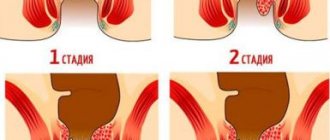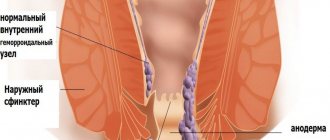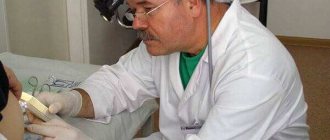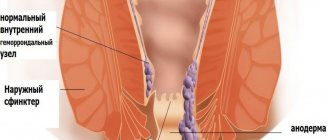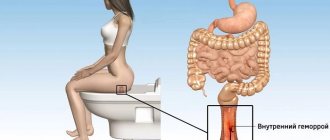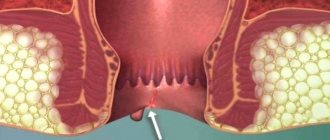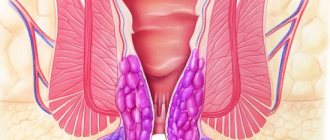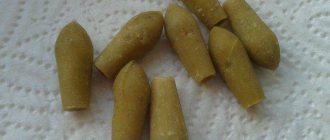In women, hemorrhoids after cesarean section are a common consequence. Enlargement of the uterus during the period of intrauterine development of the fetus and the process of delivery increases pressure on the gastrointestinal tract and provokes venous expansion in the rectum. Inflammation of hemorrhoids after cesarean section increases discomfort and unpleasant painful postoperative sensations, requiring special medical therapy.
Is it necessary to do a cesarean section for hemorrhoids?
Often expectant mothers ask whether hemorrhoids can be an indication for surgical delivery?
Hemorrhoidal disease is not an indication for cesarean section unless it has reached an advanced and complicated stage.
It should be taken into account that during pregnancy this disease worsens, and after childbirth it is more likely to progress further. This is due to the recovery period and bed rest, which will need to be observed for some time. During this period, stagnation may occur in the vessels, which means that the hemorrhoids will become inflamed in the future.
Only a proctologist together with an obstetrician-gynecologist can decide how best to give birth!
In practice, this operation is performed only in advanced forms of the disease. More often when hemorrhoids fall out and bleeding occurs.
Indications for surgery
All indications for cesarean section are divided into absolute and relative.
Among the main indications are the following:
- an existing scar on the uterus;
- placental abruption;
- some cardiovascular pathologies;
- unsuitable position of the fetus for childbirth, etc.
Preparation for surgery: taking an anamnesis, assessing the condition of the fetus, blood and urine tests, removing hair from the abdomen, purchasing compression stockings, consultation with an anesthesiologist and cardiologist.
The appearance of hemorrhoids after cesarean section
During natural childbirth, the appearance of hemorrhoidal cones is not a rare occurrence.
The surgical method of delivery, on the contrary, significantly reduces the risk of hemorrhoids during the operation itself. However, most expectant mothers notice the appearance of thrombosis and inflammation after childbirth. Moreover, the disease tends to worsen due to the load and displacement of internal organs after surgery.
Surgical intervention also makes itself felt! After it, you need to stay in bed for several days. This will lead to stagnation and increased inflammation in the nodes.
Treatment of the pathology is not always possible if the mother is breastfeeding the baby.
In this case, most medications are contraindicated. But you can resort to other methods if your doctor approves them. For example, compresses or plant-based suppositories.
Traditional medicines
Traditional recipes will help relieve the symptoms of the disease. The simplest remedy: potato candles. They are cut from whole potatoes. A potato suppository is inserted into the anus, where it can be left overnight. To lubricate hemorrhoidal cones you can use:
This video talks about hemorrhoids after Caesarean:
Baths prepared from a decoction of chamomile or onion peels are made before bed. The duration of this procedure is about 20 minutes. The course of treatment is a week. Using this method, inflammation is relieved and pain is eliminated.
Rehabilitation after surgery
The rehabilitation period after cesarean section and hemorrhoids should not pass for a long time in inactivity.
It is advisable to keep bed rest to a minimum. Doctors advise starting to move within 2-3 days, if there are no complications. In some cases, you can get out of bed the next day, but only with your doctor’s permission.
After surgery, it is recommended to start with leisurely walking. When the stitch heals and you are discharged home, you can begin other activities and exercises. For example, do light aerobics or yoga.
It is advisable to read the doctor’s extract and recommendations before resuming your previous life. It is important to monitor your health and your stitches.
If hemorrhoids begin to bother you again after surgery, then you should first try the safest treatment methods. For example, sitz baths with chamomile, potassium permanganate, or lotions made from burdock, calendula, and aloe.
Herbal medicine is an effective way to treat many pathologies, including proctological diseases.
But this method is more effective in the initial stages of the development of the disease. If the disease progresses, it is necessary to consult a proctologist regarding the selection of medications. During lactation, in order to avoid harmful substances getting into the milk, any treatment requires the approval of the attending physician.
Treatment
If a cesarean section provokes an exacerbation of hemorrhoids, treatment of the pathology should begin immediately. The main difficulty in choosing a treatment method is that most women strive to maintain natural feeding.
Therefore, independent treatment of the disease during cesarean section is strictly prohibited. After all, you need to choose drugs that are not only highly effective and have the ability to make a woman feel better, but also not harm the baby. After all, the baby is extremely sensitive to any changes in the composition of breast milk.
Treatment of hemorrhoids resulting from a cesarean section should begin as soon as the adaptation period ends.
It should be comprehensive and include rectal suppositories, creams, sitz baths and other dosage forms intended for local use. The prescription of tablet drugs must be approached responsibly, because they are characterized by a systemic effect.
It is necessary to select drugs that are not only highly effective and have the ability to make a woman feel better, but also not harm the baby.
Medication
In the treatment of hemorrhoids that occur after a cesarean section, you should use only medications recommended by a specialist.
Safe and effective products for topical use in the form of rectal suppositories:
The suppositories should be used for 7-10 days until the patient feels better. Before using the suppository, you must do an enema or cleanse the rectum using a special medicinal microenema. This will ensure maximum impact of the medicinal components on the mucous membrane. After all, if the medicine is mixed with feces, the therapeutic effect will be minimal. In addition, the introduction of a suppository can provoke a bowel movement due to irritation of the intestinal walls, which should be avoided.
How to treat illness after childbirth
Following some rules and recommendations will help avoid further development of the disease.
Firstly, after giving birth, you need to monitor your diet and avoid foods that lead to constipation. If you have problems with bowel regularity, you can consult your doctor about laxatives. During breastfeeding, suppositories are usually recommended as laxatives, as they are much safer than pills and will not affect the child’s condition.
It is recommended to eat as many fruits and vegetables as possible, which contain enough fiber. Be sure to include porridge in your diet, especially buckwheat and millet. You should stop drinking coffee, strong tea and alcohol. On the contrary, compotes are welcome.
Sometimes it is allowed to do enemas from herbal decoctions. But you shouldn’t resort to their help often.
When the suture has almost healed and the mother’s condition allows her to move normally, then it is imperative to include physical activity. At first, you should walk and do various household chores (but not heavy ones). When the doctor allows it, you need to include simple exercises. For example, do aerobics or yoga. Physical activity is necessary for everyone who has problems with veins or blood vessels.
A very good exercise that can and should be done for this disease is squeezing the buttocks. In a lying position, try to squeeze the gluteal muscles and hold them in this state for up to 5-7 seconds. Repeat 10-15 times in one approach. It is recommended to do two approaches per day. Gradually the number of approaches can be increased.
Rectal suppositories are suitable medications for treatment. It is worth paying attention to rectal suppositories that contain sea buckthorn oil or propolis. During lactation, consultation with a proctologist is required before use.
Symptoms
The intensity of clinical signs may vary. This largely depends on the situation that caused the bleeding. The severity is also determined by the amount of blood lost.
There are a number of clinical situations where losses become chronic. This usually happens if a woman has any diseases of the reproductive organs.
Many infectious pathologies and erosive processes occurring in the uterus can also lead to the development of bleeding. In this case, blood accumulates between its layers and the future developing placenta. As a rule, in this situation, a woman only notices the appearance of drops of blood on her underwear.
Persistent ones cause her to develop an anemic state, accompanied by a decrease. This condition has a detrimental effect on the intrauterine growth of the fetus, and can also lead to the formation of a number of defects and developmental anomalies.
Various traumatic effects or intense physical exercise can also provoke bleeding. Some women have reported that they experienced vaginal bleeding after lifting heavy objects.
In some cases, blood appears on underwear when visiting the toilet. In this case, it is imperative to determine the source of bleeding. If blood is released directly during urination, the cause may be related to pathologies of the kidneys or urinary tract. Often, exacerbation of chronic cystitis leads to the appearance of blood streaks in the urine.
Heavy bleeding leads to severe anemia of the woman. This even manifests itself in changes in her appearance. The skin becomes pale and cold to the touch. Lips turn blue. The area under the eyes and the area of the nasolabial triangle become gray in color.
The woman begins to feel her heart rate increase. It becomes more difficult for her to breathe. This is how the lack of oxygen manifests itself, which is caused by anemia due to severe blood loss.
When a fetus dies in the womb, a woman experiences pain in her abdomen. Its intensity increases every minute. For some women, even taking painkillers and antispasmodics in this condition does not lead to improvement in well-being. The severity of the condition is progressing every minute.
The critical degree of development of disorders is loss of consciousness. Before this, a borderline disorder usually develops - “clouding” of consciousness. The woman begins to feel dizzy, the sense of space is lost, and “spots” may flash before her eyes. Already when these symptoms occur, it is necessary to urgently call an ambulance. Delay in such a situation is very dangerous.
Advantages and disadvantages of the method
According to experts, a caesarean section should be performed only in cases where natural childbirth can occur with severe complications or the threat of death. If there are no indications for surgery, then such delivery, at the request of the patient, is not performed.
This method has both pros and cons, and often there are more cons:
| Advantages | Flaws |
| An opportunity to avoid serious complications if the woman in labor has a narrow pelvis, placental abruption, uterine fibroids, etc. | During the operation, much depends on the surgeons and their qualifications. There is a possibility of blood loss or infection in internal organs. |
| No ruptures in the birth canal. | There is still a possibility of death for a woman in labor, since a caesarean section is a complex operation with corresponding consequences. |
| The ability to avoid hemorrhoids and pelvic problems (after childbirth, the pelvic organs usually drop). | Sometimes after such surgery, mothers have problems with lactation. Milk may not appear immediately. |
| The baby does not pass through the birth canal on its own and, accordingly, its head is not deformed. | Scar. This is not only an aesthetic drawback, but also a consequence of the fact that during the next pregnancy this scar may disperse. Therefore, most often the next birth is also carried out by caesarean section. |
| There is also a negative psychological side: some mothers feel dissatisfied after such births. | |
| Research by scientists says that children born through surgery are more likely to get sick and their immunity is lower. |
Thus, a caesarean section can in some cases be a real salvation for mother and child. But this method does not always go without complications.
If you have a pathology such as hemorrhoids, then after the operation you must follow simple recommendations on lifestyle and nutrition. If the disease becomes noticeable during pregnancy, then you should immediately consult a proctologist about a suitable treatment method.
The disease can be cured without problems if it is at the initial stage of development. With advanced hemorrhoids everything is much more complicated! There is a risk of anemia, sepsis, and infection getting inside. Self-treatment in this case is not recommended, since medications during pregnancy and breastfeeding should only be selected by a doctor. Otherwise, you can harm the baby's health.
Important
Causes of blood in the stool in an adult or child
There are many diseases, even very serious ones for humans, the symptoms of which are the presence of blood in the stool:
- haemorrhoids;
- stools that are too hard;
- fissure in the anus;
- cirrhosis of the liver;
- intestinal ischemia;
- dysentery;
- amoebiasis;
- fecal peritonitis;
- stomach ulcer.
All these diseases require mandatory examination by a doctor and subsequent treatment by professionals, otherwise their development will lead to serious consequences that can only be cured through surgery. Based on some symptoms, you can independently determine the reason for the appearance of blood in the stool, but you should not trust your conclusions 100%. The following symptoms will tell you about the possible disease you are facing.
Scarlet blood on toilet paper after bowel movement
Diseases of the rectum may be accompanied by traces of blood on paper after bowel movements. These are often signs of external hemorrhoids, which require prompt treatment. If this option is not your case, then such symptoms indicate that you have developed anal fissures. The absence of pain during bowel movements means that there is nothing wrong, and the cracks appeared due to improper hygiene or other external circumstances. In this case, you can purchase ointment and lubricate the damaged areas daily until complete healing.
If you have pain and establish a more accurate diagnosis, you need to take a closer look at the color of the blood, because it can look different. Bright, scarlet blood from the anus during defecation is a sign of a fissure in the anus. A color close to brown means that the intestines are inflamed. Black color of blood threatens diseases such as cirrhosis, stomach cancer, gastritis. Only a doctor can make the correct diagnosis.
Loose stools with blood
If loose stool with blood is detected in an adult or child, this is a serious sign that the gastrointestinal tract is affected by an infectious disease. It must be treated in an isolated department and requires hospitalization of the patient during the entire course. Dysentery (as this disease is called) is dangerous even for others, because it can be caught when communicating with a patient. In addition to taking care of yourself, remember to take care of your loved ones.
Blood clots in stool
The presence of blood clots, depending on their color, indicates intestinal disease. The main causes include stomach bleeding or injury to the small intestine. Blood in the stool can indicate serious illnesses that are accompanied by the appearance of blood during bowel movements:
- about erosive gastritis;
- stomach ulcer;
- presence of stones in the stomach;
- erosive bulbite and others.
Each of these diseases affects the condition of the mucous membrane, which ultimately causes internal bleeding and discharge from the anus. Remember that stool blood test results may be incorrect if the day before you ate meat, apples, or liver. Before taking such a test, follow a diet, and only then go to the doctor with your morning stool.
Mucus with blood
The appearance of mucus with blood in the stool indicates a malignant tumor of the intestinal tract or serious diseases of the rectum. Women may experience blood during bowel movements after a difficult birth. There are many ways to treat this disease, even during lactation.
If blood is noticed during bowel movements in men, then you should pay attention to activities during the day: if there is strong physical activity, then perhaps you should stop it at least for a while. It is best to consult a specialist
With pain when defecating
Bloody stools accompanied by pain clearly indicate hemorrhoids. There are many reasons for this disease:
- poor nutrition;
- alcohol abuse;
- overstrain of the pelvic muscles;
- constant constipation that prevents you from pooping normally;
- failure to comply with hygiene standards.
Hemorrhoids can be treated quickly and have no complications if you consult a doctor in a timely manner. Sometimes pain during bowel movements are symptoms of more serious diseases, among which the more dangerous is colorectal cancer. You are unlikely to be able to diagnose it yourself, so do not waste time on self-medication and consult a specialist. All diseases of the rectum must be cured under the strict supervision of a doctor.


